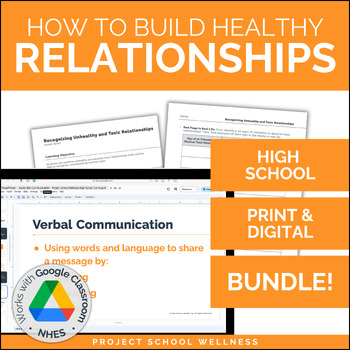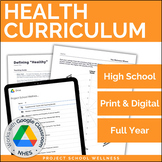How to Build Healthy Relationships | High School Health Lesson Plan Bundle
- Zip
- Google Apps™

Products in this Bundle (9)
showing 1-5 of 9 products
Bonus
Also included in
- Immerse your high school students in a transformative health and wellness journey with our comprehensive, skills-based health curriculum. Designed as a fully prepared, done-for-you program, this high school health and wellness curriculum focuses on cultivating core health skills that seamlessly intePrice $525.00Original Price $776.50Save $251.50
Description
In this Social Health and Relationship and SEL unit students will examine why relationships matter, explore characteristics of enriching relationships, develop social skills, and learn how to navigate relationships. Ultimately, the goal of this unit is for students to build the social and emotional skills needed to establish, nurture, and sustain relationships throughout their lifetimes. Throughout this skills-based health lesson plan bundle, students will explore why relationships matter, what makes relationships good, social skills, how to communicate, how to set boundaries, the difference between healthy and unhealthy relationships, relationship red flags, how to navigate toxic relationships, bullying, and more.
***This done-for-you unit is ready for digital, in-person, or hybrid learning!***
Your Students Will
- Summarize how relationships impact well-being and why it's valuable to have social connections.
- Analyze their personal relationships and distinguish how “good” relationships make them feel.
- Determine why relationships take work to maintain and identify social skills needed to build, nurture, and sustain social connections/relationships.
- Examine verbal vs. nonverbal communication and teach their peers about a specific communication skill.
- Identify a social scenario in their lives and formulate a corresponding boundary that would enhance their well-being.
- Analyze a relationship, identify red flags, and devise a plan for navigating the red flag.
- Examine unhealthy and abusive/toxic relationship traits and be able to recognize corresponding warning signs.
- Analyze bullying behaviors and formulate an idea for a school-based change that would improve the school’s social climate and lessen the existence of bullying.
- Craft scenarios featuring unhealthy and abusive/toxic relationship behaviors and formulate corresponding advice for navigating the outlined situation.
- Craft a new school policy (or amend an existing policy) designed to intentionally enhance the social well-being of students.
National Health Education Standards met in this lesson:
- 1.12.2 Describe the interrelationships of emotional, intellectual, physical, and social health.
- 2.12.2 Analyze how the culture supports and challenges health beliefs, practices, and behaviors.
- 2.12.3 Analyze how peers influence healthy and unhealthy behaviors.
- 2.12.4 Evaluate how the school and community can affect personal health
- 2.12.5 Evaluate the effect of media on personal and family health.
- 2.12.6 Evaluate the impact of technology on personal, family, and community health.
- 3.12.2 Use resources from home, school, and community that provide valid health information.
- 4.12.1 Use skills for communicating effectively with family, peers, and others to enhance health.
- 4.12.3 Demonstrate strategies to prevent, manage, or resolve interpersonal conflicts without harming self or others
- 4.12.4 Demonstrate how to ask for and offer assistance to enhance the health of self and others.
- 7.12.1 Analyze the role of individual responsibility for enhancing health.
- 7.12.2 Demonstrate a variety of healthy practices and behaviors that will maintain or improve the health of self and others.
- 7.12.3 Demonstrate a variety of behaviors to avoid or reduce health risks to self and others.
This Done-For-You lesson plan comes with:
- Instruction Video - Watch the provided teaching videos to help you navigate the complexities of mental health with confidence, comfort, and clarity.
- Teaching Guide - A detailed lesson plan requiring minimal prep and NO extra planning
- Editable Teaching PowerPoints
- Grading Rubrics - For quick and meaningful assessments
- Free updates for life!
>>> Need more high school skills-based lesson plans? - Check out our High School Curriculum
Distance Learning Compatible
This resource is hosted on Google Drive and can easily be transferred to your Google Classroom. If applicable, this resource features a Google Slides edition of the student worksheet and a Google Forms version of the learning station activity. Learn how on our blog!
Looking For More
- Free skills-based health lesson plans - Download Now!
- Free skills-based health workshop - Sign Up Here!
- Skills-Based Health Educators Facebook Group - Join!
- Health education resources and ideas - Check it out!
Google Drive Disclaimer
Upon purchase, you’ll receive a link to access your resource on Google Drive. Using Google Drive is the easiest way for us to edit and update resources. This allows us to quickly respond to feedback, share new features, and make sure this product is serving you well! If you have any issues with this, please email janelle@projectschoolwellness.com for assistance.






